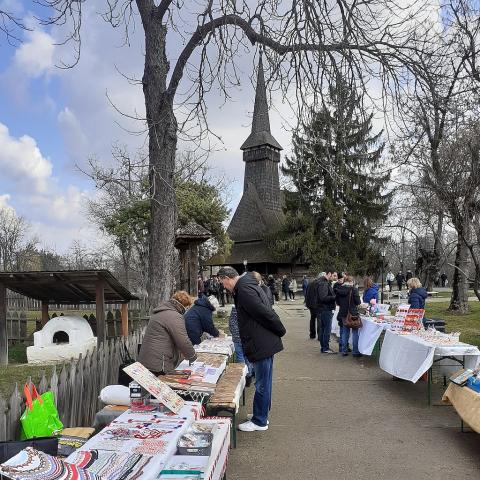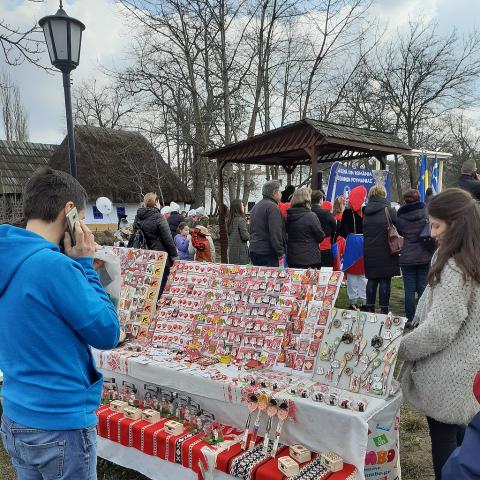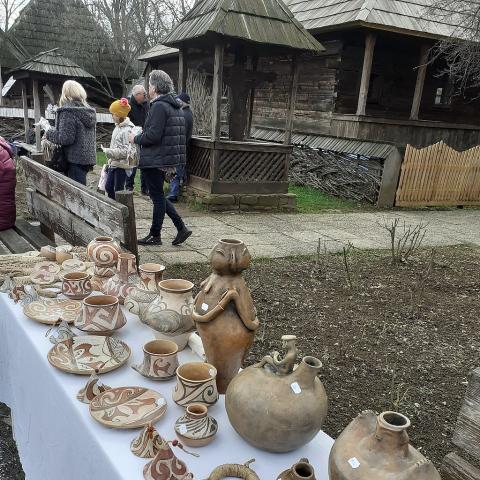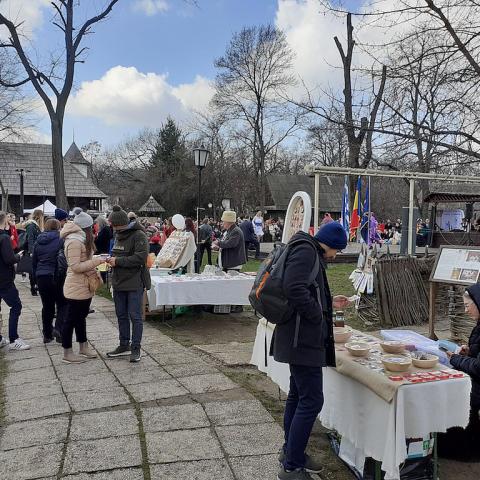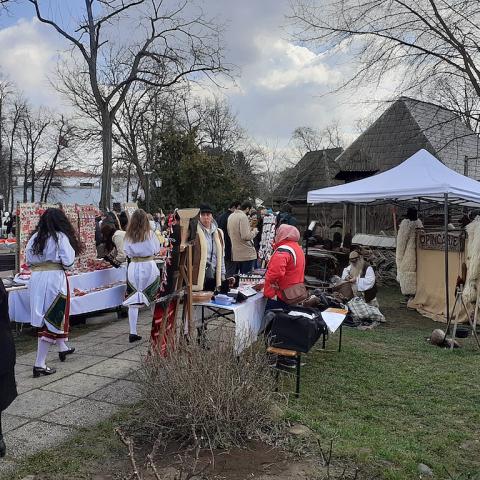“Destination: Bucharest” - At the Mărțișor Fair
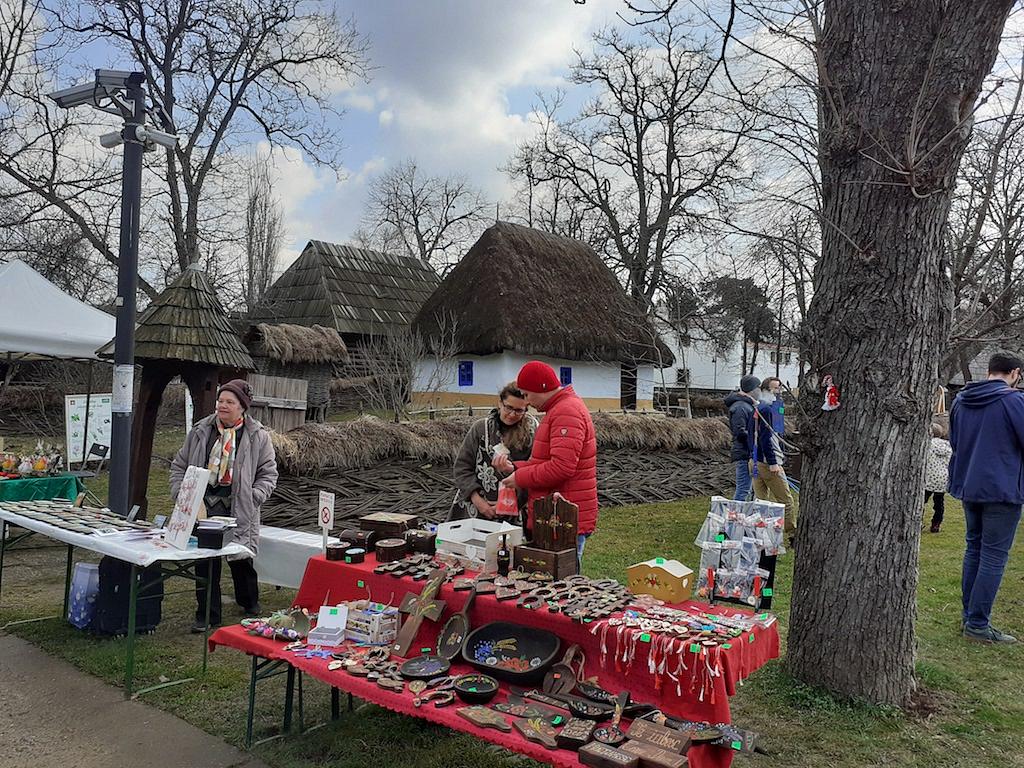
As the month of March makes its arrival, the Mărțișor tradition is under the spotlight. We visit the Mărțișor Fair at the Dimitrie Gusti National Village Museum to see what the artisans have prepared this year and how this tradition of the beginning of spring is passed on.
The alleys of the Village Museum are crowded. Among the larger groups of tourists, following their guides, couples or individual visitors walk past the houses that are part of the museum’s patrimony. They are here to discover the multitude of architectural styles, the traditional interiors and the richness of traditional, folk culture.
We go in using the Transilvania Gate from King Mihai I Park (former Herăstrău), behind two visitors having a conversation in English. We cross the alley leading to Elisabeta Palace, advance through the section dedicated to Transylvania houses and reach the Mărțișor Fair. Every year, craftsmen and artisans come here to exhibit the mărțișoare they so carefully created. The visitors are not few – parents, children, grandparents, tourists – they are all here to discover the special mărțișoare which they will later gift.
The tradition of Mărțișor is an old one and relates to the arrival of spring. This cultural practice is encountered in Bulgaria, Macedonia and the Republic of Moldova as well, and, in 2017, UNESCO added the Mărțișor to the Representative List of the Intangible Cultural Heritage of Humanity.
In its simplest form, the mărțișor is a red and white thread, offered and worn at the beginning of spring. The colors of the mărțișor symbolize the purity of the beginning, through the white string, and vitality, health, beauty or love through the red string. It is worn on the wrist or on the blouse almost the entire month and then it is tied to the sprouted branch of a fruit-bearing tree. The arrival of the storks was another indicator that it was time to put the mărţişorul aside.
In Romania, it is also encountered under the names of marţul, mărţugul and mărţiguşul. It was initially made by women and gifted in the family and the community, mainly to women. In some areas in Moldova and Transylvania it is also given to men. Today, grandparents, parents and godparents give it to children for good health, men gift it to women, children to their mothers, grandmothers or relatives.
Besides its festive function, marking the beginning of spring, the mărţişor also has a protective function. In the household, the mărţişor would be attached to the horns of the animals, at the entrances to the house or the stalls, with the belief it can ensure health in the upcoming agrarian year. It was believed it would protect the fruits of the trees, the health of the cattle, and also ensure protection against illnesses and bad luck.
The mărţişor started changing into the artefact we can see today the moment a small coin was attached to it. Ethnologist Irina Nicolau explained that this was when the city started changing the mărţişor, transforming it into the talisman-item that can be encountered today in a multitude of shapes and colors. Among these, several models have turned into classics – the four-leaved clover, symbolizing good fortune; the flower, a symbol of beauty; the chimney sweep and the horseshoe, believed to bring good luck; or the butterfly, a symbol of beauty and frailty.
In recent years, in stores or in the large supermarket and hypermarket chains, shoppers can also find mărțișoare manufactured in the People’s Republic of China, a sign that even the most traditional items were not left untouched by globalization. Still, those who appreciate the effort and creativity of artisans go shopping at various mărțișoare fairs, such as the one organized at the Village Museum and the offer does not let them down.
On display, we find a multitude of mărțișoare, of all types, colors and sizes. Cat, butterfly, bee, ladybug or owl-shape mărțișoare, the latter a favorite of hipsters, sit next to mărțișoare made of seeds, miniature replicas of the traditional blouse ia, arras-brooches, and painted sea shells. We also find mărțișoare with semi-precious stones, miniature ceramic houses, traditional decorative motifs painted on ceramics, glass or wood, mărțișoare made of clay, corn leaves or glass, and thread dolls. The mărțișoare are impressive not only visually – at one stall we find mărțișoare in the shape of knitted little hats, filled with lavender. The artisans also brought to the fair various hand-made jewelry items – earrings, rings or necklaces, called lătițare, worn at the basis of the neck, and designed with traditional motifs from various areas of the country. At another stall, we find mărțișoare made by people with disabilities. A poster urges passers by to treat them in a friendly manner and those interested can purchase the items they made and thus support their work integration.
The public seems delighted with the offer and values the artists’ work. Many of those present at the fair are children, who will gift the mărțișoare to their colleagues or their educators and teachers. They are shopping with their parents, who are teaching them to choose and be responsible. “How many [girl] colleagues do you have?” asks the father of a boy who is barely one head taller than the stall he is in front of. “Seven,” comes the answer and the lady who brought the mărțișoare starts picking the chosen model in several colors. The buyers need to cover their list of acquaintances and the mărțișoare that impress are purchased in more than one version. “How nice! We should get one for Filip!”, “Let’s get one for the French teacher!”- in between bits and pieces of conversations, the planning that takes place throughout this period, especially in the agenda of parents, emerges. For others, buying mărțișoare is an opportunity to get kids used to making choices. “Look carefully and decide!,” “You don’t need to get all of them!” – the negotiation between the grownups and the young ones is continuous, not surprising given how many beautiful mărțișoare are on display.
At the fair, we also find craftsmen who exhibit the items they have made – icons, wooden items, decorative items – but also a craftsman with an impressive beard, who is busy working. A pile of traditional footwear made out of leather (opinci) sits next to him, and grows as he designs new items.
From close by, the sound of a rhythmic Greek song can be heard. We get close and discover a group dancing at the event “It is the Time of Carnival”, organized by the Hellenic Union of Romania. The project had as guests groups representing the Democratic Forum of the Germans and the Federation of Jewish Communities in Romania, all delighting the public with their performances. Meanwhile, some walk around to evaluate the mărțișoare offer while others have gathered to watch the show. Those present are taking photos from around the stage. One father is taking pictures of his young child, possibly for the first time at a fair, and running around enthusiastically in between the stage and the stalls. The mărțișor has already worked its charm: the sky is clear and even if the sun gets covered by the clouds from time to time, spring is getting ready to settle in.
Useful:
Dimitrie Gusti National Village Museum is located at 28-30 Kiseleff Road, District 1
By bus: Arcul de Triumf station – lines 131, 205, 282, 330, 331, 335, 783, N113; Muzeul Satului station – lines 131, 205, 331, 335, N113; Institutul Agronomic station – lines 205, 330, N113
By metro: Aviatorilor station - M2 line
The access to the fair is covered by the price of the entrance ticket.
The Mărțișor fairs are organized yearly, starting with the second half of February. The dates are announced on the museums’ websites and social media channels. At the same time, throughout this period, museums also organize workshops where children can learn how to make mărțișoare.
This material is part of a project under the program of promoting the touristic heritage "Destination: Bucharest", carried out by the Bucharest City Hall through the Public Monuments and Touristic Heritage Administration (AMPT).
Photos by Romania-Insider.com for AMPT.









